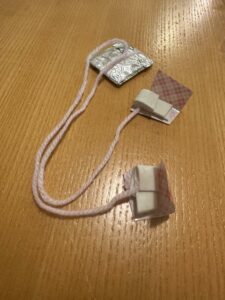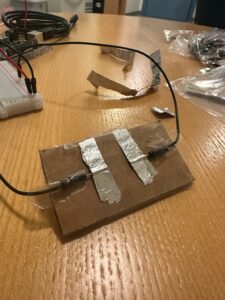Approach and Concept:
After spending a lot of time brainstorming ideas – I found one I was particularly proud of. The phrases “it happened in the blink of an eye “, “blink and you miss it” etc. are often used to talk about phenomena that happen really quickly. The literal meaning behind them is that it may as well happen that the phenomenon will start and end in the time it takes for you to finish a blink – leaving you with nothing to observe.
So how about we build a system that only does ‘something’ when you close your eyes? Thus now, every time you blink, or close your eyes – you miss ‘it’. You never actually have the experience but everyone around you does. I was personally satisfied with the concept but it was quite difficult to actually implement it given the very limited range of motion of our eyelids. Nonetheless, I ended up succeeding in doing so:
The mechanism that connects the switch to the eyelid movement. (double sided tape connects the thread to your eyelid. a piece of cardboard covered with aluminum foil and weighed down further using a coin serves as the conducting bridge.)

The switchboard. Two wires are taped to a piece of cardboard and aluminum foil is used to increase the surface area of conduction.

Demonstration:
Highlights:
The part I’m the most proud of in this project is devising the exact mechanism for the switch to work. Unlike the p5.js coding assignments, arduino and physical hardware is something I have no experience in – so this was my first time actually working with these elements and I had a lot of fun finding solutions to problems as they came up.
For example, just taping the wires to the cardboard and using the aluminum foil as the switch worked – but it wasn’t as reliable due to the uncertain points of contact between the wire ends and the foil. I managed to remedy this by putting a layer of aluminum foil on the wire ends.
Next, the switch mechanism itself didn’t have enough weight so it wouldn’t rest properly on the wire ends. I changed this by putting a small coin as to add some weight to the mechanism – and this ended up working spectacularly.
Reflections and Future Work:
I’m proud of several decisions I made in the design of this switch as I stressed earlier. However, there are quite a few things I would do differently if I had to redo the project:
First, I would find a more effective way to connect my eyelids to the switch. The current method using double-sided tape works but is very inefficient. I am still unsure as to how I would do this though.
Second, the switch itself is fairly robust to perturbations – but I believe it can be improved further aesthetically and functionally. I can use a more stable base and find better configurations to place the aluminum foil such that it covers the best area possible.
Lastly, since all my time was spent focusing on the switch, my actual design for the lights can definitely improve by a lot. I would like to add more LEDs to make my design prettier.

